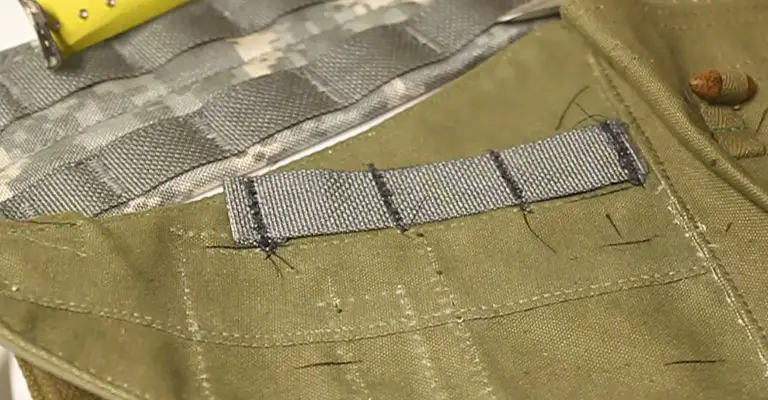To sew MOLLE (Modular Lightweight Load-carrying Equipment) webbing first, run a zigzag stitch like the picture across the rubbery material to hold it in place and toughen the strap. Use a seam ripper to remove all the stitching below the zigzag stitch. Cut off the strap and rubbery material along the unused threads with a scissor.
This article will show you the Molle webbing adding procedure easily. Let’s start.

What Webbing is Used for MOLLE
MOLLE webbing is made of nylon to ensure unmatched durability and military-grade strength. As troops need to carry attachments of various compatible pouches and accessories, rows of heavy-duty nylon are stitched onto the vest.
Nylon possesses a high tensile strength that is good for holding military or bug-out bags, or for more casual uses like long-term hikes or airsoft.
The Procedure to Sew MOLLE Webbing
Molle webbing is quite popular among military gear, backpacks, and accessories enthusiasts. It is a system developed by the US army to replace the Alice packing system which is a system of backpacks and load-bearing vests, modules, and such.
Molle works as it allows to attach components to each other using a series of woven straps creating a bond powerful enough that doesn’t bounce or fall off while in motion and therefore won’t fail. Molle is widely used to attach things like radios, rations, ammo clips, knives, grenades, first aid kits, and much more to bags and vests for military or hiking purposes.
Now describing how you attach MOLLE Webbing to a backpack –
First, lay out the rows of webbing starting with laying pieces of webbing on the bag. Measuring where the loops would end up first will be a plus point to visualize.

You can use paper diagrams or clothing chalks/water-soluble marking pencils to determine how many full loops to get. While laying out the design, consider the gadgets you will be using and plan accordingly.

After designing the layouts, the sewing part is next. For a sturdy stitch, run a straight stitch and then a zigzag stitch over the top. You can add another layer of stitching for additional strength. Cut off the strap and rubbery material along the unused threads with a scissor.
Next, you can use a heated surface or flame to melt the ends to keep them from fraying. However, make sure to melt it lightly or it will create big lumps that are difficult to sew. Check out the stitches properly to see if they can take the accessories or not.
Are PALS Webbing the Same as MOLLE
MOLLE and PALS are quite different as PALS stands for Pouch Attachment Ladder System, a webbing grid invented and patented by the United States Army while MOLLE is the attachment for the webbing. PALS is the webbing used to attach smaller equipment onto load-bearing platforms, such as military vests and backpacks.
MOLLE packs stand for modular lightweight load-carrying equipment, which is the current rucksack for most military units. Having PALS webbing allows you to use MOLLE attachments. So basically, PALS is the webbing while MOLLE is used as the attachment.
How Wide Is Molle Webbing?
Molle webbing consists of horizontal rows of 1-inch-wide straps. The spacing is 1 inch apart and sewn to the backing at 1.5-inch intervals. For both the bag and the sheath, the width of the loop space in between is similar.
To Conclude
MOLLE attachments have very few drawbacks with little room to complain. The streamlined design and ease of carrying may lead to carrying too many accessories, which is not really a problem. However, keep in mind that the external pockets may get in the way when hiking through thick brush.
Leave a Reply